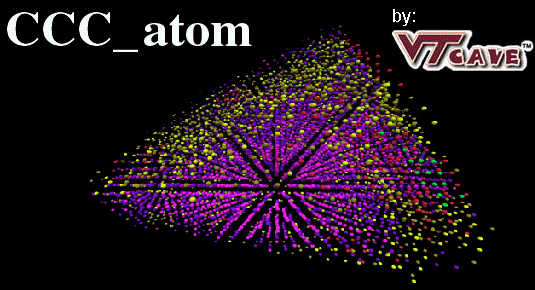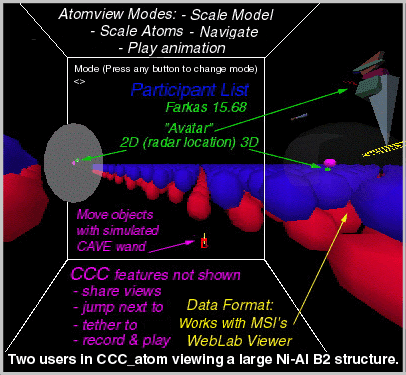

CAVERNSoft
 |
Powered by

CAVERNSoft |
|
CCC_atom is the merging of the
CAVE Collaborative
Console (CCC) with the
AtomView application used to view atomic structures. The combination
of the two allows multiple users to view, interpret, and analyze physical based
simulation models of atomic structures with collaborative tools available
within the CCC. This site provides
download access to the application, as well as instructions on installation
and how to use it. Specifically CCC_atom was desgined to enhance
scientific collaboration. A good example of the type of collaboration
between Virginia Tech
& Paul Scherrer Institute in Switzerland using AtomView can now
be enhanced using CCC_atom. CCC_atom will also be used by students
in the NSF-Combined Research Curriculum
Development (CRCD) class this Fall. A brief explanation
of atomview and the CCC are also described here. For a more
complete description of the CCC please see its own site:
CCC.
Atomview itself takes in data files with the positions and the models of the atoms you wish to use. You may input as many data files as you want indicating different positions for the atoms and these files can then be viewed in sequence to show a timeline of events in the atomic structure. |
 |
Functionality includes the ability to scale the entire model as well as the individual atoms, view the different data files in a continuous stream and the ability to navigate about the atomic structure. Because the data format for CCC_atom is compatible with MSI software, therefore AtomView files can be loaded into MSI's WebLabViewer and functionality extends to viewing these same files at desktop workstations.
The CCC gives multiple users a forum, complete with useful tools, that facilitates collaborative work. Functionality includes radar to see where other users are, a participant list to see the names and relative distances of other users, the ability to see through somebody else's eyes or jump next to them whenever needed and the convenience of being able to save a path of movements for later playback.
The merging of CCC and AtomView into CCC_atom allows users, connected by the network, to collaboratively interpret and analyze their supercomputer simulations anywhere in the world. Closely associated with CCC_atom is the Network Programming Interface Builder (NPIB) that allows users to organize, submit, and analyze their supercomputer legacy code simulations within an interactive Web-basesd Java interface. For example NPIB was used to predicted crack growth in a Ni-Al B2 structure based on legacy code developed by members of the Center for Modeling and Simulation in Materials Science (CMSMS). Our future plans are to use DIVERSE's DGL so that the collaboration can be extended to include researchers and students running Linux on Intel workstations. Together CCC_atom and NPIB can be used as productivity tools for materials researchers.
Pages written by Greg
Edwards and Ron Kriz,
http://www.sv.vt.edu/future/cave/software/cccatom/